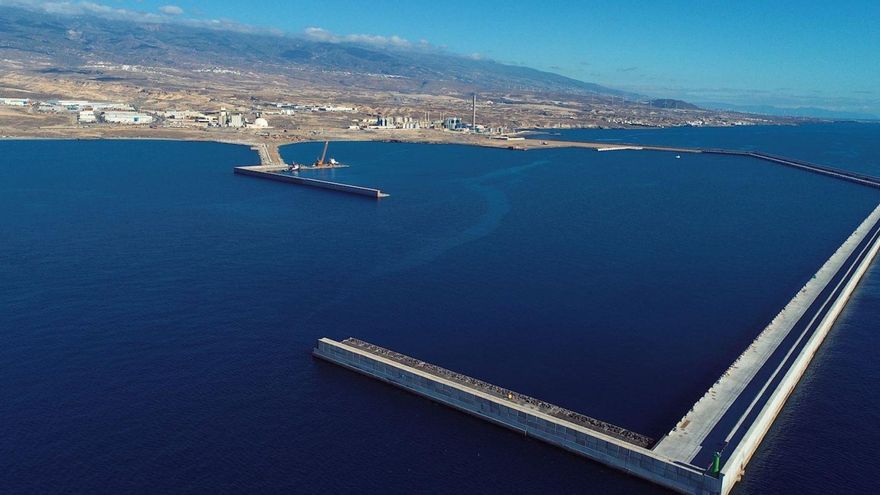
A decisive step for Cepsa to transfer its activity to the port of Granadilla de Abona and dismantle the Santa Cruz de Tenerife. The Department of Ecological Transition of the Government of the Canary Islands approved the Environmental Impact Declaration of the fuel storage park of the oil company in the infrastructure of the south of the Island. the refinery in the capital of Tenerife. The gradual process of this action that will allow the city to recover 576,000 square meters began in May of last year and will last until 2025.
ANDhe project to be installed in the southern port infrastructure will occupy 46,680 square meters. It includes the construction of eleven fuel storage tanks and two more for Marpol, a type of waste. The Regional Executive Counselor José Antonio Valbuena recalled the link between the construction of this park and the dismantling of the Refinery in Santa Cruz.
The Declaration is approved after analyzing the project, observing the environmental values, carrying out an assessment of the possible environmental impact and studying the proposal for protective and corrective measures and its environmental monitoring plan.
46,680
Square meter
- The new Cepsa plant project will occupy 46,680 square meters. Includes eleven fuel storage tanks and two for Marpol, a type of waste
The approved project contemplates the construction of eleven fuel storage tanks –gasoline, diesel and kerosene–, two for Marpol and a tank loader.
All the auxiliary facilities necessary for the correct operation of the plant will also be built. Among others, the pumping system, the drainage networks, the hydrocarbon water treatment model or the treatment of the aforementioned Marpol. In addition, the buildings attached to the storage facilities will also be installed on the plot: the access control building, the central room, the electrical and communication infrastructure building, the workshop and the warehouses.
Port Use Zone
Deputy Minister Miguel Ángel Pérez explained that the construction will occupy 46,680 square meters on a plot with a concession area of 119,169, located entirely within the Complementary Port Use Zone of the Port of Granadilla. It is bordered to the north by a cement grinding plant in the Industrial Estate and to the south by the future container area of the port itself.
The area corresponds to the classification of Rustic Land for the Protection of Infrastructures, Resources and Equipment. It is located within the Complementary Port Use and within the framework of the categories of Light Industry, Logistics Activities, Storage, Tertiary Port Equipment, Institutional and Port Administration.
The environmental authorization to undertake the construction of the plant in Granadilla represents another step on the long road towards the recovery of the land of the Refinery for Santa Cruz de Tenerife. An old aspiration of the citizenry with different moments in its development.
576,000
Square meter
- The City Council-Cepsa agreement will allow the recovery of 576,000 square meters for the city in “the largest urban operation in the country,” according to PP councilor Carlos Tarife.
The most recent chronology refers to 2018, the year of formalization of Santa Cruz Verde 2030, the plan agreed between the Santa Cruz City Council and Cepsa for the urban regeneration of the land currently occupied by the Refinery, the longest-lived in Spain, built in 1930 and paralyzed for more than a decade. The key would be in the new General Urban Planning Plan (PGOU) to implement what, in the words of the then Councilor for Urban Planning and today for Public Services, Carlos Tarife (Popular Party), will be “the largest urban operation in the country”. . The initiative will begin to take shape so that all the land occupied by the Refinery becomes land for residential and tourist use.
First phase works
In January 2022, the Department of Ecological Transition of the Government of Canary Islands authorized the imminent start of work for the first phase of the dismantling of units of the Santa Cruz de Tenerife Refinery. The President of the Canary IslandsÁngel Víctor Torres, and the CEO of Cepsa, Maarten Wetselaar, discussed the details of a process included in “the strategy to promote sustainability and the energy transition”.
In May 2022, the Minister of Ecological Transition of the Government of Spain, Teresa Ribera, presided over the institutional and historical act that began the total dismantling. A refining industry will give way, after the decontamination of the land, to a green area, homes, spaces for leisure or offices. The Refinery goes to the Port of Granadilla to continue with its fuel storage activity. The Environmental Impact Statement is now a decisive step for that.
















